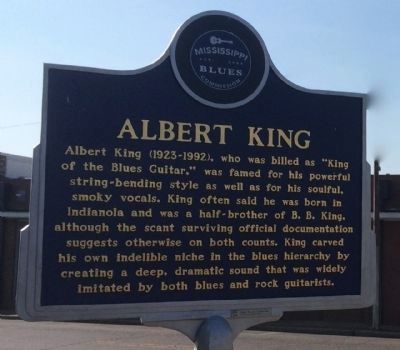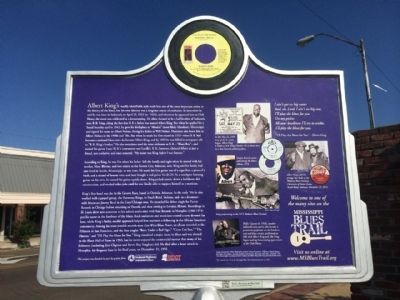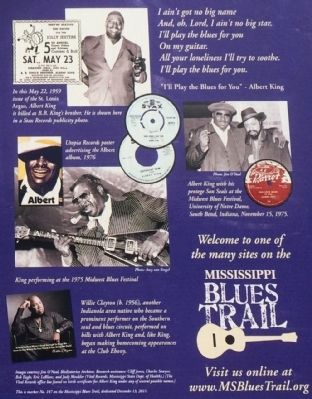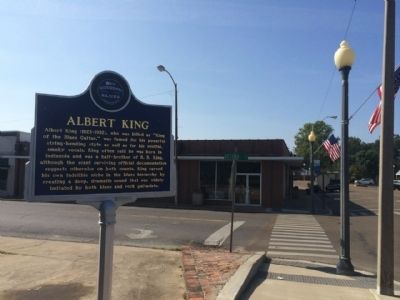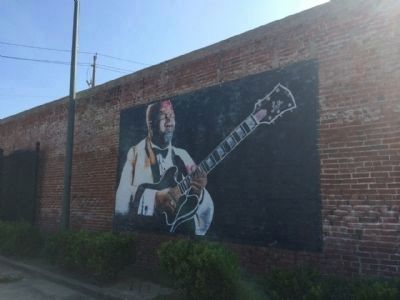Indianola in Sunflower County, Mississippi — The American South (East South Central)
Albert King
Albert King (1923-1992), who was billed as "King of the Blues Guitar," was famed for his powerful string-bending style as well as for his soulful, smoky vocals. King often said he was born in Indianola and was a half-brother of B. B. King, although the scant surviving official documentation suggests otherwise on both counts. King carved his own indelible niche in the blues hierarchy by creating a deep, dramatic sound that was widely imitated by both blues and rock guitarists.
Albert King’s readily identifiable style made him one of the most important artists in the history of the blues, but his own identity was a longtime source of confusion. In interviews he said he was born in Indianola on April 25, 1923 (or 1924), and whenever he appeared here at Club Ebony, the event was celebrated as a homecoming. He often claimed to be a half-brother of Indianola icon B. B. King, citing the fact that B. B.'s father was named Albert King. But when he applied for a Social Security card in 1942, he gave his birthplace as “Aboden” (most likely Aberdeen), Mississippi, and signed his name as Albert Nelson, listing his father as Will Nelson. Musicians also knew him as Albert Nelson in the 1940s and '50s. But when he made his first record in 1953–when B. B. had become a national blues star–he became Albert King, and by 1959 he was billed in newspaper ads as “B. B. King's brother.” He also sometimes used the same nickname as B. B.–“Blues Boy”–and named his guitar Lucy (B. B.'s instrument was Lucille). B. B., however, claimed Albert as just a friend, not a relative, and once retorted, “My name was King before I was famous.”
According to King, he was five when his father left the family and eight when he moved with his mother, Mary Blevins, and two sisters to the Forrest City, Arkansas, area. King said his family had also lived in Arcola, Mississippi, at one time. He made his first guitar out of a cigar box, a piece of a bush, and a strand of broom wire, and later bought a real guitar for $1.25. As a southpaw learning guitar on his own, he turned his guitar upside down. King picked cotton, drove a bulldozer, did construction, and worked other jobs until he was finally able to support himself as a musician.
King's first band was the In the Groove Boys, based in Osceola, Arkansas. In the early ’50s he also worked with a gospel group, the Harmony Kings, in South Bend, Indiana, and–as a drummer–with bluesman Jimmy Reed in the Gary/Chicago area. He recorded his debut single for Parrot Records in Chicago before returning to Osceola and then moving to Lovejoy, Illinois. Recordings in St. Louis drew new attention to his talents and a stint with Stax Records in Memphis (1966-1974) put his name in the forefront of the blues. Rock audiences and musicians created a new, devoted fan base, while King's funky, soulful approach helped him maintain a following in the African American community. Among his most notable records were Live Wire/Blues Power, an album recorded at the Fillmore in San Francisco, and the Stax singles “Born Under a Bad Sign,” “Cross Cut Saw,” “The Hunter,” and “I'll Play the Blues for You.” King remained a major name in blues and was elected to the Blues Hall of Fame in 1983, but he never enjoyed the commercial success that many of his followers (including Eric Clapton and Stevie Ray Vaughan) did. He died after a heart attack in Memphis, his frequent base in his final years, on December 21, 1992.
Erected 2011 by the Mississippi Blues Commission. (Marker Number 147.)
Topics and series. This historical marker is listed in these topic lists: African Americans • Arts, Letters, Music • Entertainment. In addition, it is included in the Mississippi Blues Trail series list. A significant historical month for this entry is April 1903.
Location. 33° 27.074′ N, 90° 39.082′ W. Marker is in Indianola, Mississippi, in Sunflower County. Marker is at the intersection of Front Avenue and Second Street, on the left when traveling south on Front Avenue. Touch for map. Marker is at or near this postal address: 118 Front Avenue, Indianola MS 38751, United States of America. Touch for directions.
Other nearby markers. At least 8 other markers are within walking distance of this marker. Fannie Lou Hamer (about 400 feet away, measured in a direct line); Riley B. King (about 400 feet away); Craig Claiborne (approx. 0.2 miles away); Church Street (approx. 0.2 miles away); Irene Magruder (approx. 0.3 miles away); Club Ebony (approx. 0.3 miles away); Wayne and Minnie Cox Park (approx. 0.4 miles away); Giles Penny Savers Store (approx. 0.6 miles away). Touch for a list and map of all markers in Indianola.
Also see . . . Mississippi Blues Trail. (Submitted on September 20, 2014, by Mark Hilton of Montgomery, Alabama.)
Credits. This page was last revised on October 5, 2020. It was originally submitted on September 20, 2014, by Mark Hilton of Montgomery, Alabama. This page has been viewed 554 times since then and 45 times this year. Photos: 1, 2, 3, 4, 5. submitted on September 20, 2014, by Mark Hilton of Montgomery, Alabama. • Bernard Fisher was the editor who published this page.
